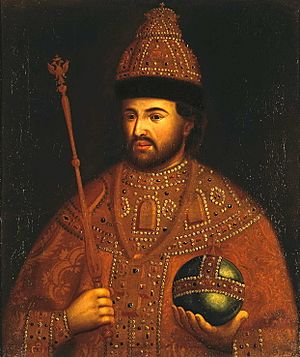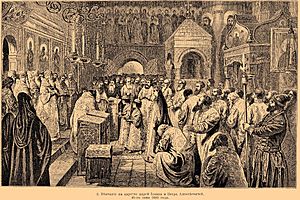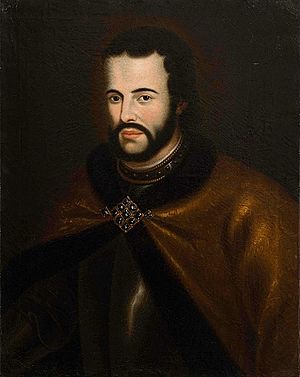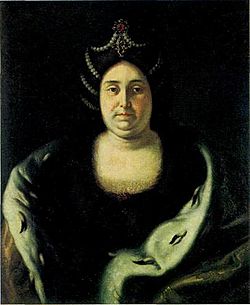Ivan V of Russia facts for kids
Quick facts for kids Ivan V |
|||||
|---|---|---|---|---|---|
 |
|||||
| Tsar of all Russia | |||||
| Reign | 7 May 1682 – 8 February 1696 | ||||
| Coronation | 25 June 1682 | ||||
| Predecessor | Feodor III | ||||
| Successor | Peter I | ||||
| Co-monarch | Peter I | ||||
| Regent | Sophia Alekseyevna (1682–1689) | ||||
| Born | 6 September 1666 Moscow, Tsardom of Russia |
||||
| Died | 8 February 1696 (aged 29) Moscow, Tsardom of Russia |
||||
| Burial | Archangel Cathedral | ||||
| Spouse |
Praskovia Saltykova
(m. 1684) |
||||
| Issue more... |
|
||||
|
|||||
| House | Romanov | ||||
| Father | Alexis of Russia | ||||
| Mother | Maria Miloslavskaya | ||||
| Religion | Eastern Orthodox | ||||
Ivan V Alekseyevich (born September 6, 1666 – died February 8, 1696) was a Tsar of all Russia. He ruled from 1682 to 1696. He shared the throne with his younger half-brother, Peter I.
Ivan was the youngest son of Alexis I of Russia and his first wife, Maria Miloslavskaya. Peter was the only son of Alexis and his second wife, Natalya Naryshkina. Ivan's rule was mostly just a title because he had serious health problems.
Contents
Early Life and Becoming Tsar
Ivan V was born in 1666 in Moscow. He was the youngest son of Tsar Alexis. Only two of his older brothers lived past childhood. His oldest brother, Alexei, died at age 15. So, his second brother, Feodor, became tsar when their father died.
When Feodor died in 1682, he had no children. This caused a problem for who would rule next. Ivan was the next oldest brother, but people thought he was "sick in body and mind." Some suggested skipping over him. They wanted his younger half-brother, Peter, to become tsar instead. Peter was only 10 years old but was healthy and seemed ready to lead later.
The church and Peter's mother's family, the Naryshkins, supported Peter becoming tsar. However, Ivan V's mother's family, the Miloslavskis, and Ivan's older sister, Sofia Alekseyevna, disagreed. Rumors spread that Feodor III had been poisoned. People also rumored that Ivan was killed so young Peter could become Tsar.
These rumors led to the Moscow Uprising of 1682. The streltsy, who were special soldiers, stormed the Kremlin. These troubles stopped only after Ivan showed himself in public. He proved to everyone that he was alive and well.
The streltsy demanded that Ivan be named tsar. So, a compromise was reached. Ivan and Peter were both declared co-rulers. A regency government was set up to rule until the boys grew up. Sofia Alekseyevna, who was powerful in the court, was named regent.
Co-Rulers of Russia
On June 25, 1682, Ivan and Peter were crowned as co-Tsars. This happened less than two months after Feodor III died. Their coronation took place in the Cathedral of the Dormition. A special throne with two seats was made for them. You can see it today in the Kremlin Armoury.
Ivan was 16 years old at this time, and Peter I was only 10. Ivan was seen as the "senior tsar." But the real power was held by Sophia Alekseyevna. She was Ivan's full sister and Peter's half-sister. She ruled as regent for the next seven years.
Sophia always treated Ivan with respect. However, she rarely asked for his opinion on important matters. She made sure everyone showed Ivan respect. This was a way to reduce the influence of Peter's supporters in the court. Ivan's wishes were always considered, and his standing in court remained strong during Sophia's regency.
As Peter grew up, he and his supporters, led by his mother's family, the Naryshkins, started to challenge Regent Sophia for power. Tensions grew between the groups supporting the two co-tsars.
In 1689, Peter was 17. He wanted to declare himself an adult and take full power. To stop this, Sophia tried to start a riot in Moscow. She spread false rumors that Ivan's crown was destroyed and his room was on fire. This was not true. When riots began, Ivan's tutor, Prince Prozorovsky, convinced him to speak publicly. Ivan declared his trust in his brother Peter. He also said he was safe and not in danger.
Ivan did this and supported Peter's idea that the regency should end. Peter was declared an adult, and Sophia's regency was over. Ivan was not interested in ruling and was not able to. So, Peter took over and acted as if he were the only tsar. Over time, the respect and power Ivan once had slowly faded. He became less important in the Russian court. For the last ten years of his life, Ivan was completely overshadowed by the more active Peter I. He spent his days with his wife, Praskovia Saltykova, mostly focused on "fasting and praying."
Marriage and Family
In late 1683 or early 1684, Ivan married Praskovia Saltykova. She was the daughter of Fyodor Petrovich Saltykov, a minor nobleman. Ivan's marriage was arranged in the traditional Russian way. He chose his bride from a group of possible candidates.
Praskovia Saltykova came from a less known family. She was raised in a normal household and believed in traditional values. She became very close to her gentle and kind husband. She was a great support for him. She was an excellent wife to a man who had mental challenges. Everyone admired her good character, simple life, kindness, and religious devotion. She also stayed out of politics.
She earned the lasting respect of her powerful brother-in-law, Peter the Great. Peter even trusted her to care for and educate his own two daughters. He asked her to raise them to be just like herself.
Ivan's health problems did not stop him from having strong children. Praskovia gave birth to five daughters. Three of them lived to adulthood. Their children were:
- Maria Ivanovna (1689–1692), who died as a baby.
- Feodosia Ivanovna (1690–1691), who also died as a baby.
- Ekaterina Ivanovna (1691–1733), who was the grandmother of Ivan VI of Russia.
- Anna Ivanovna (1693–1740), who later ruled as Empress of Russia. She had no children.
- Praskovia Ivanovna (1694–1731), who had one son who died as a baby.
Death and What Happened Next
When Ivan was 27, foreign visitors described him as old, unable to move well, and almost blind. He died two years later, on February 8, 1696. He was buried in the Archangel Cathedral. It was good for Peter's supporters that Ivan had several daughters but no sons. This meant there was no confusion about who would rule next. With Ivan's death, Peter became the sole ruler of Russia. The struggle for power in the family finally ended.
In 1730, more than 30 years after Ivan's death, his second living daughter, Anna, Duchess of Courland, was invited to become Empress of Russia. She ruled for over 10 years. She was followed by Ivan's great-grandson, Ivan VI of Russia, who was a baby. However, a palace coup in 1741, led by Ivan's niece Elizabeth, meant the throne eventually went to the descendants of Peter the Great.
See also
 In Spanish: Iván V de Rusia para niños
In Spanish: Iván V de Rusia para niños




